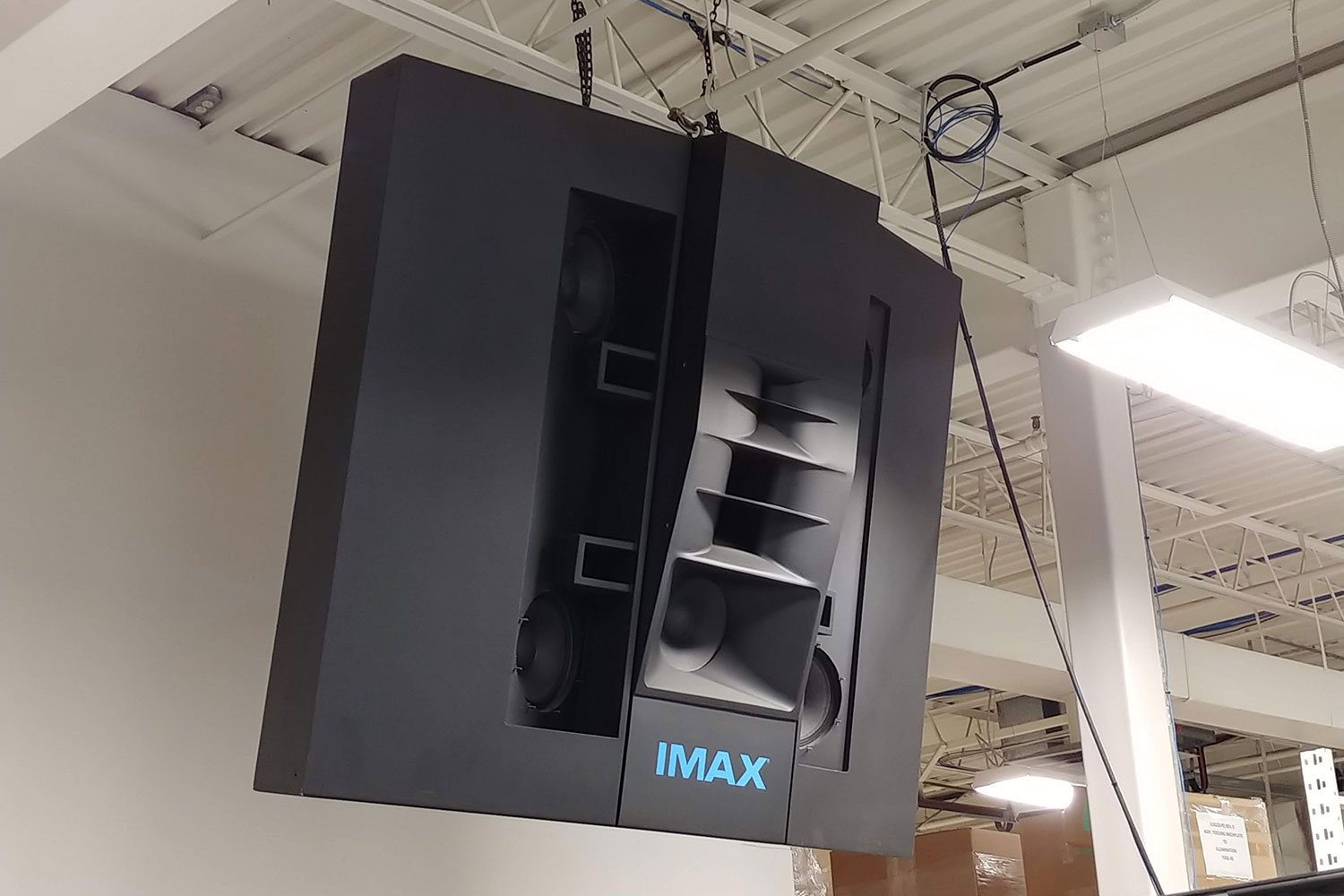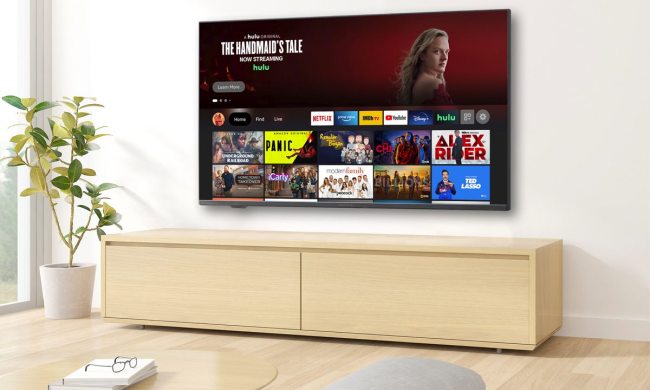There really is nothing like the sheer grandeur of IMAX.
Soaring on the wing of Tom Hardy’s RAF Spitfire above the emerald Atlantic ocean, courtesy of the 80-foot screen stowed within IMAX’s Toronto, Ontario headquarters, was a stirring reminder of just what IMAX can do to your senses.
Prior to my Toronto trip it had been several years since I’d experienced IMAX (and “experience” is surely the right word), a 3D viewing of Avatar being my last pilgrimage to the mega screen. Thanks in no small part to the company’s latest advancements in laser projection technology, the format has only gotten better since, and Christopher Nolan’s 70mm tour de force, Dunkirk, was definitely a proper reintroduction.
Spectral highlights along the water and cloud-patched sky sparkled with vivid realism.
The plane’s Rolls Royce engine buzzed with guttural, muscle-car force, spectral highlights along the water and cloud-patched sky sparkled with vivid realism, and the film grain, magnified by the monstrous screen size, added just the right mixture of new tech and old-school movie magic to pull me in. The Dunkirk clip was part of a 20-minute demo handpicked by IMAX’s higher-ups to pitch its new laser projectors to mega theater chains like AMC and Regal/Cineworld. Suffice it to say, it’s an impressive presentation.
The battle for eyeballs
With 50 years of experience in the business, screens in over 1,300 locations, and its new laser projection technology rolling out into multiple theaters, IMAX seems as vital today as it’s ever been.
This, despite the fact that the company is under siege on all fronts: There’s Dolby Cinema’s own dazzling new laser projection technology, an encroaching new emissive LED Cinema screen from Samsung hoping to disrupt the industry altogether, a cornucopia of high-end home theater products – from Dolby Atmos to OLED TVs – and the languid seduction of streaming, all seeming to beckon would-be IMAX viewers to other corners of the entertainment universe.

Yet, to hear IMAX’s exuberant Chief Technology Officer Brian Bonnick tell it, when it comes to competitors, IMAX has no fear.
“We live the niche.” Bonnick says. “They don’t.”
He has a point. While not all of IMAX’s theaters boast mega screens like the one in its headquarters, even in its smaller theaters, IMAX’s curated sound and projection systems, its wrap around screens, and its stringent regulations and 24/7 support make it among the most sought-after theater experiences in existence.
Bonnick’s cool demeanor also seems to stem from the fact that IMAX has been leading — and redefining — the cinema landscape for its entire five decades now, continuously reinventing and refining its own technology. The theater veteran compares the company to a hotrod, always retooling and tacking on new parts for a more thrill-inducing ride.
Because, lasers
IMAX’s latest retool, and the subject of our visit to the company’s Toronto-based research and development center, is the company’s new laser-powered projectors, specifically its new single-projection laser system. Lasers aren’t new for IMAX – its dual laser projection system, called the GT, has been in select theaters for a few years now. But this latest creation is the first to use a single projector that provides the full “IMAX with Laser” experience on smaller IMAX screens (where an 80-foot tall screen still counts as “smaller”), making it less expensive and easier to implement in more theaters.
Laser light provides myriad improvements over traditional xenon projector lamps, including brighter images (IMAX’s laser projections gets about 60 percent brighter than standard projectors), more colors, and perhaps most importantly, better contrast.
Laser projection provides myriad improvements over traditional xenon projector lamps.
For its new projectors, IMAX has essentially miniaturized its laser tech to cut costs for smaller theaters, where IMAX uses wrap-around screens placed closer to the audience to keep its all-important peripheral immersion. The system offers a 1.9:1 aspect ratio (as opposed to the GT’s 1.43:1) and requires less maintenance than dual-projector systems, which must be calibrated and digitally enhanced to meet IMAX’s rigorous specifications for a perfectly synced image.
Part of the secret to the new system is what the company calls “dual-coupled” lasers, which look like thick cannisters set beneath the projector’s lens. These offer a more direct injection of laser light that allows the projectors to be housed in smaller projection rooms, among other benefits. In contrast, the dual projection system uses fiber-coupled lasers, which winds the laser light through fiber optic tubing, slightly degrading the light.
The projectors are made using space-age materials, including Invar, a nickel-iron alloy which Bonnick claims is one of the most thermally stable materials in existence, as well as another mystery material that’s stronger than steel and made of materials IMAX doesn’t divulge to us media types.

Both projection systems are powered by the same laser-light engine which uses IMAX’s patented prism-less lighting tech, developed in part thanks to a haul of around 120 patents IMAX scrapped from the wreck of what was once Kodak, scooping up 30 engineers in the process. Instead of forcing laser light through glass prisms like traditional xenon projectors (and even Dolby’s laser projection system), IMAX’s laser projectors send red, green, and blue lasers directly to each of three modulation chips (called Digital Micromirror Device chips) mounted on an Invar frame, which reduces the amount of optical glass the image must pass through.
According to IMAX, the Invar design provides a steadier image thanks to better cooling of each of the three chips, along with improved contrast, and a sharper image for better accuracy in detail, measured down to the micron. As we said, these guys are serious about this stuff.
The projectors are made using Invar, one of the most thermally stable materials in existence.
Bonnick also claims only IMAX’s laser system can create true black on screen, in spite of the fact that Dolby’s system offers incredible contrast and better brightness, reaching 38 foot-lamberts compared to IMAX’s 22. Bonnick even admits that Dolby’s system can offer more striking contrast when it comes to images with less color, such as a star-littered sky – something I can account for thanks to a recent viewing of The Force Awakens in Dolby Cinema, where I was consistently blown away by the shots in space.
On the flipside, Bonnick says when it comes to “interframe contrast” where multiple shades of whites and blacks are shown on screen at once, IMAX’s system has the advantage because it’s actually creating a black image. “When Dolby goes black, they are actually turning off two of the chips,” Bonnick says. He claims this makes IMAX’s laser system better at showing realism, whereas Dolby Cinema, he admits, wins with some sci-fi content.
To play off Bonnick’s car reference, you can think of it a bit like comparing a Ferrari to a Lamborghini – both have their fortes, and you’re going to have a hell of a good time taking a seat in either.
Serious sound
Of course, while laser projection was the plat du jour of our tour, we’d be remiss if we didn’t talk about IMAX’s balls-to-the-wall sound system, which again, differs from Dolby’s ever-encroaching Atmos system, but has plenty to crow about. Unlike the object-based, 3D sound delivered by Atmos, which allows for as many as 64 individual speakers in a theater to deliver singular placement of “sound objects,” IMAX’s system is a more old-school.
The company uses massive, horn-loaded speakers developed in-house to create a 12-channel sound system, and unlike every other surround system in existence, it also allows for full-range audio signal delivery to the bass channel. Frankly, when it comes to ultimate surround immersion, we’ll still take Atmos, as it simply has more speakers to work with, and therefore, more options.

That said, IMAX’s speakers have some real advantages. Developed and curated to IMAX’s exact specifications in three different sizes — including towering monstrosities that look like something you’d see in the bat cave — the system offers room shaking power, gorgeous midrange and treble detail, and deep musical bass. In fact, the system we heard in IMAX’s Toronto theater, which included 8 (count them, 8) subwoofers, and utilized the company’s “proportional point source” system, was among the most gorgeous we’ve ever heard.
This aided by IMAX’s impressive acoustic treatment, which cupped our ears in solemn, reflection-less silence the moment we entered the Toronto theater. And, to Bonnick’s point, while Dolby and other theaters rely on third-party speakers, IMAX not only hand-tailors its speakers, but the company’s 24/7 help desk – which handles 94 percent of all technical issues remotely – can do things like instantly compensating for a dead speaker by boosting power to the rest of the system via computers, all from halfway across the world.
The future?
There’s no denying that IMAX’s laser projection offers the kind of experience that’s hard to match anywhere else in cinema. But can the company stay viable in the ever-changing entertainment landscape?
After experiencing it myself, and speaking with the company’s leadership, it’s evident that IMAX isn’t clinging to its past glories like some aging theatrical dinosaur. In fact, IMAX seems as well-positioned to capture the cinematic zeitgeist today as it was when its first mondo-sized screens started showing … well, dinosaurs.
It’s evident that IMAX isn’t clinging to its past glories like some aging theatrical dinosaur.
“Our biggest group is fanboys,” Bonnick told us, and they’ve been ready and willing to pay up for IMAX’s grander theaters. This is the “experience first” generation, after all, where 20-somethings are much more apt to go out for a good meal or hit a club than spend money on possessions or clothing. When younger audiences do get off their phones to go to a theater, Bonnick said, they want a premium experience. That fits IMAX to a T — especially when it comes to its biggest and brightest screens — and the company has also been exploring other experience-based entertainment avenues, such as VR.
Bonnick sees a future where the 24-theater multiplex is slowly replaced by 10 or 12-theater venues, with an IMAX screen at one end, and a feature-tied VR parlor (or something similar) in the lobby.
As for Samsung’s new, ultra-bright LED Cinema screens? IMAX is keeping its eye on the tech, but Bonnick thinks it’s a long way off, claiming it’s still way too expensive to create. Even if they could, Bonnick thinks they wouldn’t know what to do with it to create a “film-like experience.”
Wherever the entertainment landscape turns, IMAX expects to be there, with the latest technology in tow. And we, the movie-going public, will be better off for it.






